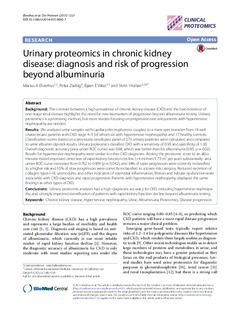| dc.contributor.author | Øvrehus, Marius Altern | |
| dc.contributor.author | Zürbig, Petra | |
| dc.contributor.author | Vikse, Bjørn Egil | |
| dc.contributor.author | Hallan, Stein | |
| dc.date.accessioned | 2015-11-10T09:57:41Z | |
| dc.date.accessioned | 2015-11-24T11:29:29Z | |
| dc.date.available | 2015-11-10T09:57:41Z | |
| dc.date.available | 2015-11-24T11:29:29Z | |
| dc.date.issued | 2015 | |
| dc.identifier.citation | Clinical Proteomics 2015, 12(1) | nb_NO |
| dc.identifier.issn | 1559-0275 | |
| dc.identifier.uri | http://hdl.handle.net/11250/2365414 | |
| dc.description.abstract | Background: The contrast between a high prevalence of chronic kidney disease (CKD) and the low incidence of
end-stage renal disease highlights the need for new biomarkers of progression beyond albuminuria testing. Urinary
proteomics is a promising method, but more studies focusing on progression rate and patients with hypertensive
nephropathy are needed.
Results: We analyzed urine samples with capillary electrophoresis coupled to a mass-spectrometer from 18 well
characterized patients with CKD stage 4–5 (of whom six with hypertensive nephropathy) and 17 healthy controls.
Classification scores based on a previously developed panel of 273 urinary peptides were calculated and compared
to urine albumin dipstick results. Urinary proteomics classified CKD with a sensitivity of 0.95 and specificity of 1.00.
Overall diagnostic accuracy (area under ROC curve) was 0.98, which was better than for albuminuria (0.85, p = 0.02).
Results for hypertensive nephropathy were similar to other CKD diagnoses. Adding the proteomic score to an albuminuria
model improved detection of rapid kidney function decline (>4 ml/min/1.73 m2 per year) substantially: area
under ROC curve increased from 0.762 to 0.909 (p = 0.042), and 38% of rapid progressors were correctly reclassified
to a higher risk and 55% of slow progressors were correctly reclassified to a lower risk category. Reduced excretion of
collagen types I–III, uromodulin, and other indicators of interstitial inflammation, fibrosis and tubular dysfunction were
associated with CKD diagnosis and rapid progression. Patients with hypertensive nephropathy displayed the same
findings as other types of CKD.
Conclusions: Urinary proteomic analyses had a high diagnostic accuracy for CKD, including hypertensive nephropathy,
and strongly improved identification of patients with rapid kidney function decline beyond albuminuria testing.
Keywords: Chronic kidney disease, Hypertensive nephropathy, Urine, Albuminuria, Proteomics, Disease progression | nb_NO |
| dc.language.iso | eng | nb_NO |
| dc.publisher | BioMed Central | nb_NO |
| dc.title | Urinary proteomics in chronic kidney disease: diagnosis and risk of progression beyond albuminuria | nb_NO |
| dc.type | Journal article | nb_NO |
| dc.type | Peer reviewed | en_GB |
| dc.date.updated | 2015-11-10T09:57:41Z | |
| dc.source.volume | 12 | nb_NO |
| dc.source.journal | Clinical Proteomics | nb_NO |
| dc.source.issue | 1 | nb_NO |
| dc.identifier.doi | 10.1186/s12014-015-9092-7 | |
| dc.identifier.cristin | 1264877 | |
| dc.description.localcode | © 2015 Øvrehus et al. This article is distributed under the terms of the Creative Commons Attribution 4.0 International License (http://creativecommons.org/licenses/by/4.0/), which permits unrestricted use, distribution, and reproduction in any medium, provided you give appropriate credit to the original author(s) and the source, provide a link to the Creative Commons license, and indicate if changes were made. The Creative Commons Public Domain Dedication waiver (http://creativecommons.org/publicdomain/zero/1.0/) applies to the data made available in this article, unless otherwise stated. | nb_NO |
